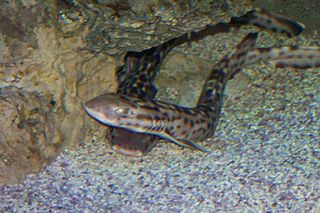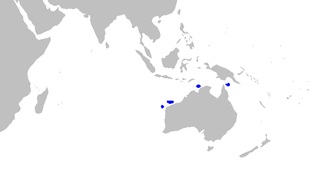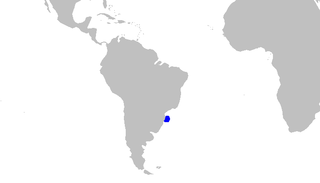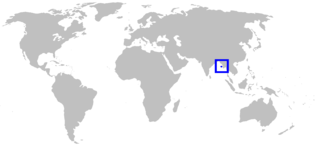
Catsharks are ground sharks of the family Scyliorhinidae. They are the largest family of sharks with around 160 species placed in 17 genera. Although they are generally known as catsharks, some species can also be called dogfish due to previous naming. However, a dogfish may generally be distinguished from a catshark as catsharks lay eggs while dogfish have live young. Like most bottom feeders, catsharks feed on benthic invertebrates and smaller fish. They are not harmful to humans. The family is paraphyletic, containing several distinct lineages that do not form a monophyletic group.

Atelomycterus is a genus of coloured catsharks in the family Atelomycteridae.

The coral catshark is a species of coloured catshark belonging to the family Atelomycteridae. It is common on shallow coral reefs across the Indo-West Pacific, from Pakistan to New Guinea. Reaching up to 70 cm (28 in) in length, the coral catshark has an extremely slender body, a short head and tail, and two dorsal fins that are angled backwards. It can be identified by the numerous black and white spots on its back, sides, and fins, which often merge to form horizontal bars. Furthermore, adult males have distinctively long and thin claspers.

The Bali catshark is a species of coloured catshark, belonging to the family Atelomycteridae, found only off the Indonesian island of Bali. It can grow up to 47 cm (19 in). Atelomycterus baliensis inhabits the deep coastal waters of Bali, Indonesia, feeding on small fish and invertebrates.

The dwarf catshark is a catshark, belonging to the family Scyliorhinidae. It is found off the coast of southern Florida, the Bahamas, and Cuba and is also known as the whitespotted catshark and Cuban catshark.

The quagga catshark is a species of catshark, belonging to the family Scyliorhinidae. A small, slim-bodied shark reaching 37 cm (15 in) in length, it has a distinctive color pattern of narrow, dark brown vertical bars, which resemble those of the quagga. Its head is short and flattened, with a pointed snout tip that is not upturned.

The cloudy catshark is a common species of catshark, belonging to the family Scyliorhinidae. It is a bottom-dweller that inhabits rocky reefs in the northwestern Pacific Ocean, from the shore to a depth of 320 m (1,050 ft). Growing up to 50 cm (20 in) long, this small, slim shark has a narrow head with a short blunt snout, no grooves between the nostrils and mouth, and furrows on the lower but not the upper jaw. It is also characterized by extremely rough skin and coloration consisting of a series of dark brown saddles along its back and tail, along with various darker and lighter spots in larger individuals.

The West African catshark is a catshark of the family Scyliorhinidae. It is found in the eastern Atlantic between latitudes 20° N and 17° S, at depths between 45 and 500 m. It can grow up to a length of 80 centimetres (31 in). At one time, the West African catshark was considered to be a subspecies of the nursehound, Scyliorhinus stellaris, but is now considered to be a separate species. The reproduction of this catshark is oviparous.

The whitesaddled catshark is a species of catshark, and part of the family Scyliorhinidae. It is found on the upper continental slope of the western central Atlantic Ocean, off the coasts of Honduras, Panama and Colombia, between latitudes 22° N and 9° N, at depths between 274 and 457 m. It can grow to a length of 47 cm (19 in). The reproduction of this catshark is oviparous but otherwise, little is known about its biology.

The slender sawtail catshark is a little-known species of catshark, part of the family Scyliorhinidae, endemic to northern Australia. It is found over the continental slope in 290–470 m (950–1,540 ft) on water. Growing to 34 cm (13 in) long, this shark has a slim gray body with four dark saddle markings below the dorsal fins and on the caudal fin, as well as a prominent crest of enlarged dermal denticles along the dorsal edge of the caudal fin. The slender sawtail catshark is not valued by fisheries but is taken as bycatch. The International Union for Conservation of Nature (IUCN) presently lacks enough information to assess its conservation status.

The longnose sawtail catshark is a little-known species of catshark, part of the family Scyliorhinidae, found off the northwestern Pacific islands of Amami Ōshima, Ogasawara, and Izu at depths of 350–550 m (1,150–1,800 ft). Reaching a length of 80 cm (31 in), it is characterized by a long flattened snout, a long space between the pelvic and anal fins, and a crest of enlarged dermal denticles along the dorsal caudal fin edge. Adults are plain dark gray above, while juveniles have a few faint dark saddles on the back and tail.

The southern sawtail catshark is a species of catshark, part of the family Scyliorhinidae, endemic to southern Brazil. It inhabits deepwater reefs on the upper continental slope at a depth of 236–600 m (774–1,969 ft). Reaching at least 43 cm (17 in) in length, this slim-bodied species closely resembles the Antilles catshark. It has a prominent crest of enlarged dermal denticles along the dorsal edge of the caudal fin, as well as a distinctive color pattern of dark oval blotches, outlined in white, along its back. The southern sawtail catshark is oviparous, with females producing reddish egg capsules. The International Union for Conservation of Nature (IUCN) has assessed it as Vulnerable; it is often taken as bycatch and may be threatened by intensifying squid fishing.

The broadfin sawtail catshark is a common species of catshark, part of the family Scyliorhinidae. It is found on or near the bottom at depths of 150–540 m (490–1,770 ft), from southeastern Japan to the East China Sea. A slender species growing to 68 cm (27 in) long, this shark is characterized by a fairly long, pointed snout, a series of indistinct, dark saddles along its back and tail, and a prominent crest of enlarged dermal denticles along the dorsal edge of its caudal fin. In addition, adult males have very long claspers that reach past the anal fin. The broadfin sawtail catshark is an opportunistic predator of bony fishes, cephalopods, and crustaceans, with immature and mature sharks being primarily piscivorous. It is oviparous and reproduces year-round.

The blacktip sawtail catshark is a species of catshark, and part of the family Scyliorhinidae, found off the coasts of Taiwan and the Philippines. It is demersal in nature and occurs deeper than 60 m (200 ft). Growing up to 46 cm (18 in) long, this slim-bodied species is characterized by its plain brownish dorsal coloration with dark tips on the dorsal and caudal fins, and a prominent crest of enlarged dermal denticles on the upper edge of the caudal fin. It is oviparous, with females producing encapsulated eggs two at a time year-round. The blacktip sawtail catshark is caught incidentally in bottom trawls and used for fishmeal in Taiwan.
The Triton epaulette shark is a species of bamboo shark in the genus Hemiscyllium, that is composed of nine morphologically similar, yet distinct, sharks that are geographically restricted to New Guinea and northern Australia. Hemiscylliidae are small nocturnal sharks aptly named "walking sharks" who exhibit a "crawling" movement while foraging on the ocean floor for fish and benthic invertebrates.
Figaro is a genus of catshark, and part of the family Scyliorhinidae. Until 2008, Figaro was generally considered to be a subgenus of Galeus. The two known species are found off Australia, inhabiting deep, offshore waters on or near the bottom. Figaro contains small, slender, firm-bodied sharks that bear distinctive crests of enlarged, spiny dermal denticles along the dorsal and ventral edges of their short caudal fins. The caudal peduncle is relatively long, such as that the anal and caudal fins are some distance apart. In adult males, the inner margins of the pelvic fins are fused together to form a subtle "apron" over the claspers. F. boardmani is a predator of fishes, crustaceans, and cephalopods, and is oviparous; less is known about the F. striatus. Both are harmless and are of no economic importance.
The phallic catshark is a little-known species of catshark, belonging to the family Scyliorhinidae. It is found on or near the ocean floor, in the deep waters off New Caledonia and Vanuatu. A slender species attaining a length of 46 cm (18 in), it is characterized by a long caudal fin bearing a crest of enlarged dermal denticles along the dorsal margin, and very long claspers in adult males. This shark is gray-colored, with four dark saddles along the back and tail.

The magnificent catshark or clown catshark is a species of finback catshark, belonging to the family Proscylliidae, known only from five specimens collected in the northern Andaman Sea near the edge of the Myanmar continental shelf. Its common names refer to its distinctive, elaborate color pattern of small and large dark spots, which include "clown faces" beneath each dorsal fin. Reaching 49 cm (19 in) in length, this species has a very slender body with a short, flattened head and a large lobe of skin in front of each nostril. The first dorsal fin is placed behind the pectoral fins but ahead of the pelvic fins.

The Indonesian angelshark is a rare species of angelshark, family Squatinidae, known only from a few specimens collected from fish landing sites in southern Indonesia. It is thought to inhabit the deep waters of the continental slope. Reaching at least 1.34 m (4.4 ft) long, this species has a flattened, ray-like shape and a well-developed tail and caudal fin. It is characterized by the absences of fringes on its nasal barbels and thorns down the midline of its back, as well as by its relatively plain grayish-brown dorsal coloration with dark saddles beneath the dorsal fin bases and a black leading margin on the underside of the pectoral fins. The International Union for Conservation of Nature (IUCN) has classified it as Critically Endangered due to significant fishing pressure.

Atelomycteridae, the coloured catsharks, is a family of sharks belonging to the order Carcharhiniformes. These sharks are found in the Indian, Pacific and Western Atlantic Oceans.

















